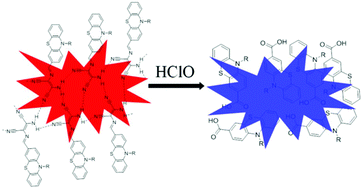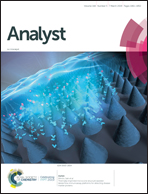From aggregation-induced to solution emission: a new strategy for designing ratiometric fluorescent probes and its application for in vivo HClO detection†
Abstract
In this paper, we introduced a new strategy for converting aggregation-induced emission (AIE) to fluorescence emission in solution into the rational design of new fluorescent probes. Two fluorescent probes based on this strategy, namely, PDAM-Lyso and PDAM-Me, have been synthesized and tested both in vitro and in vivo. The fluorophores of the two probes are both phenothiazine molecules, which link to the diaminomaleonitrile (DAMN) moiety through imine bonds. In the presence of imine bonds, the probes emit red fluorescence in an aqueous solution caused by the AIE effect. As the imine bonds are selectively cut-off by HClO, the DAMN moiety gets removed, inducing blue fluorescence of the reaction product. In this way, the selectivity of the DAMN-based probes toward HClO against metal ions and other reactive oxygen species (ROS) was successfully improved. The imaging of endogenous and exogenous HClO with these two probes reveals that lysosome-targeting probes are of great advantage in the detection of natively generated HClO. Furthermore, the imaging of endogenous HClO in zebrafish suggests that PDAM-Lyso is capable of monitoring the generation of HClO in vivo, illustrating that this strategy is of great significance in designing new probes.

- This article is part of the themed collection: Celebrating 100 years of Chemistry at Nanjing University


 Please wait while we load your content...
Please wait while we load your content...